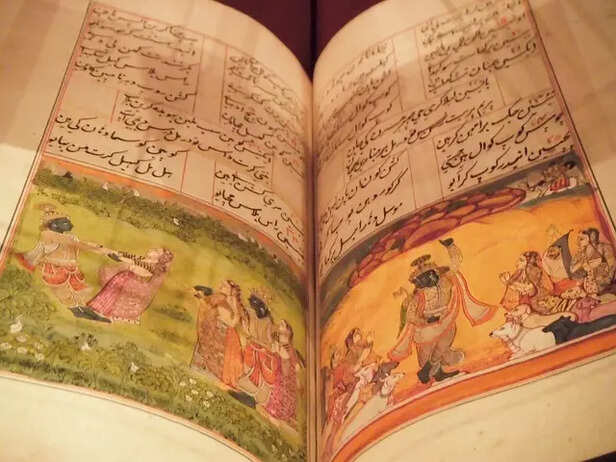Why Is the World Turning to Indian Spirituality for Mental Peace
Nishi rawat | Apr 19, 2025, 19:30 IST
The power of Indian Spirituality.
In an age of noise, speed, and digital burnout, the world is increasingly seeking answers from ancient traditions that offer silence, depth, and true calm. Indian spirituality, with its roots in timeless practices like meditation, pranayama, mantra chanting, and yoga, is emerging as a global guide to mental peace. This article explores why people across cultures are now embracing these Indian spiritual teachings — not just for spiritual awakening, but for emotional balance, stress relief, and inner clarity. From Vedic wisdom to yogic breathing, this is a deep dive into how practices honed over thousands of years are becoming the modern-day remedy for the chaos of the mind.
Imagine a crowded subway in New York, a café in Paris, a yoga retreat in Bali, or even a tech hub in Silicon Valley—and you’ll notice a common thread. From mantras to meditation, the world is increasingly tuning into Indian spiritual wisdom to navigate the growing mental chaos of modern life.
But why India? Why now? And what is it about Indian spirituality that has captured the imagination of the global soul?
Let’s dive into this beautiful, unexpected, and timely shift.
![Anxiety attacks and panic attacks among people.]()
In a world where “burnout” is a badge of honor and anxiety has become a silent epidemic, people are desperately searching for something real—something deeper than surface-level self-care routines or temporary escapes.
According to the World Health Organization, depression is one of the leading causes of disability worldwide, and anxiety affects over 275 million people globally. The rise of digital distraction, hustle culture, and hyper-connectivity has taken a toll on our inner world.
This collective fatigue has triggered a soul-search. And increasingly, that search leads east.
For centuries, the West emphasized material progress, technological innovation, and external success. But in doing so, something vital was left behind: the inner journey. The result? Outer abundance, inner emptiness.
Indian spirituality flips that script. In Indian traditions, peace isn’t something you achieve by acquiring more—it’s something you uncover by letting go. It teaches that the real battle is within, and victory means mastering your mind, not your market share.
![Bhagwat Geeta, Yoga and Meditation.]()
Indian spiritual philosophies, from Vedanta to Buddhism, offer profound tools for inner clarity and emotional resilience:
![Spirituality is beyond religions, casts and countries.]()
This isn’t just spiritual tourism—it’s a revolution of the soul.
Hollywood celebrities like Julia Roberts, Russell Brand, and Will Smith have spoken publicly about how Indian spirituality changed their lives. Steve Jobs, in his youth, made a pilgrimage to India. Mark Zuckerberg, when struggling with Facebook’s direction, turned to Indian teachings upon advice from Jobs.
Even Ivy League institutions are exploring mindfulness and Indian philosophy. Harvard, Stanford, and MIT have all incorporated meditation and yoga studies into their curricula, not as fads—but as powerful cognitive and emotional tools.
Modern Indian spiritual masters like Sadhguru, Sri Sri Ravi Shankar, and Mooji have built global followings. Their teachings aren’t packaged as religion—they’re offered as inner science. This approach resonates with a generation seeking spirituality without dogma.
These masters speak the language of the 21st century, yet channel the essence of timeless truths. Their retreats, YouTube videos, books, and global events are helping millions reconnect with what truly matters: presence, purpose, and peace.
![Vedas and Puran's.]()
One of the most powerful reasons Indian spirituality is gaining global traction is science.
Modern neuroscience, psychology, and medical research increasingly validate what ancient Indian texts claimed thousands of years ago. For example:
One of the biggest misconceptions about Indian spirituality is that it's tied to religion. But Indian traditions like Advaita Vedanta and Samkhya are deeply philosophical and open-ended. They invite inquiry, not blind faith.
The core idea is: you are not your thoughts, your emotions, or even your body—you are something far more permanent and peaceful beneath it all.
This non-religious, self-inquiry-based path is deeply appealing to modern seekers who want transformation without being labeled or bound.
The more the world chases happiness through things—gadgets, likes, achievements—the more disillusioned it becomes.
Indian spirituality is a radical act in this context. It whispers, “Everything you’re looking for is already within you.” That’s not a slogan—it’s a practice. Through silence, stillness, self-reflection.
In this way, Indian spiritual traditions aren’t just healing minds—they’re quietly dismantling a global culture obsessed with doing, proving, and having.
![Today's generation and Bhakti.]()
What’s most surprising? This shift isn’t driven by the old—it’s led by the young.
Gen Z and millennials are flocking to online satsangs, mindfulness apps rooted in Indian teachings, and spiritual podcasts. They're meditating between meetings, journaling before bed, and attending yoga festivals with the enthusiasm once reserved for concerts.
They’re not seeking religion—they’re seeking realness. And they’re finding it in the ancient mantras, quiet rituals, and introspective philosophies of India.
Today, you don’t need to travel to Rishikesh or Varanasi to learn meditation or attend a spiritual discourse. Indian spirituality has gone digital.
Apps like Sattva, Headspace, and Insight Timer feature Indian teachers and teachings. YouTube channels dedicated to the Gita, meditation, and spiritual psychology have millions of views. Instagram is full of Sanskrit quotes, mindfulness reels, and sound bowl therapy inspired by Indian roots.
It’s a new kind of globalization—one where India exports not products, but peace.
![Inner war after Covid.]()
The COVID-19 pandemic served as a wake-up call for millions around the world. Locked in their homes, separated from routines and distractions, many turned inward for the first time.
Search trends during the pandemic showed massive spikes in meditation, mindfulness, yoga, and spiritual inquiry. Indian teachings became a lifeline—guiding people through fear, loss, and uncertainty.
And once people tasted that calm, they wanted more.
Indian spirituality doesn’t promise a life free of problems. What it offers is something far more valuable: the ability to remain calm despite them.
It teaches how to detach from outcomes, act with sincerity, and remain rooted in the present. It helps people see the difference between pain and suffering—and provides tools to transcend both.
It’s not about escapism. It’s about elevating consciousness.
Trends come and go—but true transformation leaves a mark. And the global embrace of Indian spirituality seems less like a trend and more like a tectonic shift in human consciousness.
As technology accelerates, as politics divide, and as mental health challenges rise, people will keep searching for stillness. And time and again, they’ll find it in India’s spiritual treasure chest.
The world isn’t turning to Indian spirituality because it’s exotic—it’s turning to it because it’s effective. In a time of external chaos, Indian wisdom offers an inner compass.
It reminds us that peace isn’t something we earn, hustle for, or find somewhere out there. It’s something we uncover—through awareness, through practice, through presence.
As the ancient Indian saying goes:
“Asato ma sad gamaya, tamaso ma jyotir gamaya, mrityor ma amritam gamaya”
(Lead me from untruth to truth, from darkness to light, from death to immortality.)
The world is listening. And slowly, beautifully, awakening.
Explore the latest trends and tips in Health & Fitness, Travel, Life Hacks, Fashion & Beauty, and Relationships at Times Life!
But why India? Why now? And what is it about Indian spirituality that has captured the imagination of the global soul?
Let’s dive into this beautiful, unexpected, and timely shift.
The Mental Health Crisis No One Can Ignore

Anxiety attacks and panic attacks among people.
In a world where “burnout” is a badge of honor and anxiety has become a silent epidemic, people are desperately searching for something real—something deeper than surface-level self-care routines or temporary escapes.
According to the World Health Organization, depression is one of the leading causes of disability worldwide, and anxiety affects over 275 million people globally. The rise of digital distraction, hustle culture, and hyper-connectivity has taken a toll on our inner world.
This collective fatigue has triggered a soul-search. And increasingly, that search leads east.
The East Has What the West Forgot
Indian spirituality flips that script. In Indian traditions, peace isn’t something you achieve by acquiring more—it’s something you uncover by letting go. It teaches that the real battle is within, and victory means mastering your mind, not your market share.
The Allure of Timeless Wisdom

Bhagwat Geeta, Yoga and Meditation.
Indian spiritual philosophies, from Vedanta to Buddhism, offer profound tools for inner clarity and emotional resilience:
- Yoga is not just exercise; it's a philosophy that harmonizes body, mind, and soul.
- Meditation isn’t a wellness trend in India; it’s a millennia-old path to self-realization.
- The Bhagavad Gita, often called the manual of life, teaches how to stay steady in the face of chaos.
- Ayurveda, the sister science of yoga, offers holistic mental and physical healing based on individual constitution.
This wisdom isn’t just ancient—it’s timeless. And its universal nature is what draws people in across cultures, languages, and belief systems.
Hollywood, Harvard, and Himalayan Monks

Spirituality is beyond religions, casts and countries.
This isn’t just spiritual tourism—it’s a revolution of the soul.
Hollywood celebrities like Julia Roberts, Russell Brand, and Will Smith have spoken publicly about how Indian spirituality changed their lives. Steve Jobs, in his youth, made a pilgrimage to India. Mark Zuckerberg, when struggling with Facebook’s direction, turned to Indian teachings upon advice from Jobs.
Even Ivy League institutions are exploring mindfulness and Indian philosophy. Harvard, Stanford, and MIT have all incorporated meditation and yoga studies into their curricula, not as fads—but as powerful cognitive and emotional tools.
The Globalization of the Guru
These masters speak the language of the 21st century, yet channel the essence of timeless truths. Their retreats, YouTube videos, books, and global events are helping millions reconnect with what truly matters: presence, purpose, and peace.
Science Now Backs What Indian Seers Said

Vedas and Puran's.
One of the most powerful reasons Indian spirituality is gaining global traction is science.
Modern neuroscience, psychology, and medical research increasingly validate what ancient Indian texts claimed thousands of years ago. For example:
- Meditation changes the structure of the brain, increasing grey matter and reducing stress.
- Yogic breathing (pranayama) balances the nervous system and improves emotional regulation.
- Chanting mantras like “Om” synchronizes brain activity and induces calm.
It's Not Religion—It’s Inner Engineering
The core idea is: you are not your thoughts, your emotions, or even your body—you are something far more permanent and peaceful beneath it all.
This non-religious, self-inquiry-based path is deeply appealing to modern seekers who want transformation without being labeled or bound.
A Rebellion Against Consumer Culture
Indian spirituality is a radical act in this context. It whispers, “Everything you’re looking for is already within you.” That’s not a slogan—it’s a practice. Through silence, stillness, self-reflection.
In this way, Indian spiritual traditions aren’t just healing minds—they’re quietly dismantling a global culture obsessed with doing, proving, and having.
Young People Are Waking Up

Today's generation and Bhakti.
What’s most surprising? This shift isn’t driven by the old—it’s led by the young.
Gen Z and millennials are flocking to online satsangs, mindfulness apps rooted in Indian teachings, and spiritual podcasts. They're meditating between meetings, journaling before bed, and attending yoga festivals with the enthusiasm once reserved for concerts.
They’re not seeking religion—they’re seeking realness. And they’re finding it in the ancient mantras, quiet rituals, and introspective philosophies of India.
Digital Spirituality: India Goes Global
Apps like Sattva, Headspace, and Insight Timer feature Indian teachers and teachings. YouTube channels dedicated to the Gita, meditation, and spiritual psychology have millions of views. Instagram is full of Sanskrit quotes, mindfulness reels, and sound bowl therapy inspired by Indian roots.
It’s a new kind of globalization—one where India exports not products, but peace.
The Pandemic Was a Turning Point

Inner war after Covid.
The COVID-19 pandemic served as a wake-up call for millions around the world. Locked in their homes, separated from routines and distractions, many turned inward for the first time.
Search trends during the pandemic showed massive spikes in meditation, mindfulness, yoga, and spiritual inquiry. Indian teachings became a lifeline—guiding people through fear, loss, and uncertainty.
And once people tasted that calm, they wanted more.
From Crisis to Consciousness
It teaches how to detach from outcomes, act with sincerity, and remain rooted in the present. It helps people see the difference between pain and suffering—and provides tools to transcend both.
It’s not about escapism. It’s about elevating consciousness.
Will This Shift Last?
As technology accelerates, as politics divide, and as mental health challenges rise, people will keep searching for stillness. And time and again, they’ll find it in India’s spiritual treasure chest.
Conclusion: A Homecoming of the Soul
It reminds us that peace isn’t something we earn, hustle for, or find somewhere out there. It’s something we uncover—through awareness, through practice, through presence.
As the ancient Indian saying goes:
“Asato ma sad gamaya, tamaso ma jyotir gamaya, mrityor ma amritam gamaya”
(Lead me from untruth to truth, from darkness to light, from death to immortality.)
The world is listening. And slowly, beautifully, awakening.
Explore the latest trends and tips in Health & Fitness, Travel, Life Hacks, Fashion & Beauty, and Relationships at Times Life!
Frequently Asked Questions (FAQ's) -
- How to find peace through spirituality?
By connecting with your inner self through mindfulness, meditation, and living with purpose. - How to get peace of mind in Hinduism?
By practicing dhyana (meditation), following dharma (righteous living), and surrendering to the divine with faith. - What are practices of spirituality?
Meditation, self-reflection, prayer, gratitude, and living in alignment with your higher values
